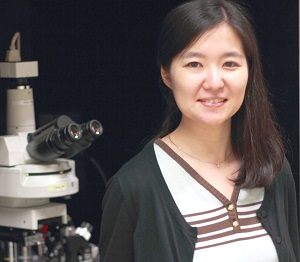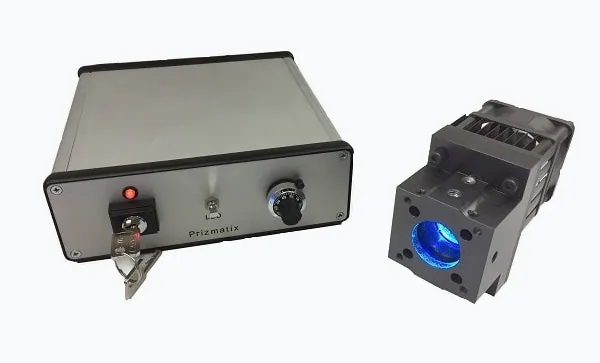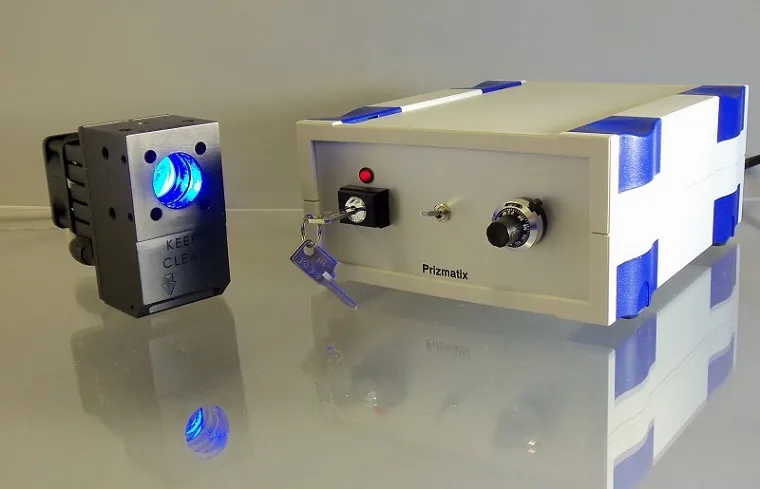
Research led by Dr. Sachiko Tsuda of the Duke-NUS Graduate Medical School in Singapore is directed at better understanding the functional organization of neuron circuits in the brain. She and her colleagues in the lab of Prof. George Augustine recently developed an all-optical approach to study how groups of neurons collectively communicate within brain networks.
“Our optogenetic approach enables both the control and detection of the activity of entire populations of neurons simultaneously by using light, which makes it easier to map the connections between different neuron populations,” said Dr. Tsuda, the lead author of their recently published paper. The researchers achieved photostimulation of multiple neurons via the lightsensitive cation channel, channelrhodopsin-2, using the Prizmatix UHP-Mic-LED-460 as the light source and the Andor Mosaic digital micromirror device to create arbitrary spatial patterns of illumination. They simultaneously detected the postsynaptic responses via voltage sensitive dye imaging.
“Since voltage-sensitive dye imaging enables observation of synaptic inhibition as well as excitation, we can visualize inhibitory circuits that largely remain to be elucidated,” Dr. Tsuda said.

“The strong output of UHP-Mic-LED-460 solved this problem very effectively. As a bonus, the simple control of its LED via TTL signals also helped us to simplify synchronization of our optical and electrophysiological instruments.”
Because they were photostimulating multiple neurons, it was challenging to get enough light power to efficiently activate each neuron. “The strong output of UHP-Mic-LED-460 solved this problem very effectively,” Dr. Tsuda said. “As a bonus, the simple control of its LED via TTL signals also helped us to simplify synchronization of our optical and electrophysiological instruments.”
The Prizmatix UHP-Mic-LED-460 provides more than 1.5 W of collimated light, with a peak excitation of 460 nm, and is optimal for photostimulating a large number of neurons. Prizmatix LEDs all feature a direct TTL input for fast switching with a rise/fall time of microseconds, much faster than the millisecond pulses required for optogenetic applications.
As a proof-of-principle, the researchers used their technique to control the activity of cerebellar interneurons while simultaneously recording inhibitory responses in multiple Purkinje neurons, which are the postsynaptic targets for the interneurons. The results demonstrated that their all-optical technique allows rapid and quantitative analysis of the spatial organization of neuronal circuits.
“We believe that this approach will greatly aid understanding of the functional organization of neuronal circuits,” Dr. Tsuda said.
The researchers are now working to increase the resolution of photostimulation mapping by optimizing the detection of neuronal responses, and they plan to try the approach with genetically encoded fluorescent indicators to achieve cell-type specificity for the neuronal responses. Dr. Tsuda adds that their approach could be used to analyze neuronal circuits in intact brains, and for such in vivo applications, the UHP-Mic-LED-460 would be a key component because of its high power and simple control.
Research Paper: Tsuda S, Kee MZ, Cunha C, Kim J, Yan P, Loew LM, Augustine GJ.. Probing the function of neuronal populations: combining micromirror-based optogenetic photostimulation with voltage-sensitive dye imaging. Neurosci Res. 2013 Jan;75(1):76-81
 UHP-LED for patterned illumination
UHP-LED for patterned illumination
Prizmatix Products for Research
In this research Dr. Tsuda used Prizmatix Ultra High Power Collimated LED (P/N: UHP-Mic-LED-460),
the best product for year 2013. Since then we improved UHP product lines and now Prizmatix offers more advanced models.
Currently main product lines are:
UHP-T-MP – Most powerful collimated LED with rectangular shape LED emitter (about 3x4mm).
Providing rectangular beam for applications such as microplate illumination.
UHP-T-DI - Powerful collimated LED with square shape LED emitter (3x3mm).
Providing square beam for application such as epifluorescence microscopy,
petri dish illumination, optional 5mm core light guide coupling.
UHP-T-EP – Powerful and high brightness collimated LED with square shape LED emitter (2x2mm).
Providing square beam for application such as epifluorescence microscopy, DMD, Optogenetics,
optional 3mm core light guide coupling.
UHP-T-SR – Ultra Bright collimated LED with small LED emitter (several sizes available).
Providing extra brightness for application such as epifluorescence microscopy, Optogenetics,
optional 3mm core light guide coupling and fiber coupling.
Advantages of UHP-T series:
Location of high current LED driverIn UHP-T-LED the high current LED driver is located inside LED head rather than in controller. In similar products from other vendors the high current driver located in the controller box. When high current flows from controller to LED head high RFI/EMI interference may disturb delicate measurements. In UHP-T-LED models the LED head is grounded and serve as Faraday cage reducing the RFI/EMI interference.
Optically Isolated TTL and Analog InputsThe controller of UHP-T-LED features, as standard, TTL input for very fast triggering (or ON/OFF strobing) of LED light without need of a shutter. The Analog input provides simple way to control the LED light power from computer. Both inputs are independent and optically isolated to eliminate ground loops.
Low Optical Noise OptionMost modules can be purchased with Low Noise (-LN) option. The low optical noise light source is very important in experiments involving such measurements as cell membrane potential imaging by Voltage-Sensitive Dyes (VSD) (potentiometric dyes). In many preparations the change of Voltage-Sensitive Dye fluorescence signal may be just few percent. If the excitation light source exhibits high intensity fluctuations the small VSD changes may be obscured. UHP-T-LED-LN has intensity fluctuations of less than 0.01% RMS between DC to 1MHz, enabling detection of small changes in Voltage-Sensitive Dye fluorescence intensity.

The contemporary LED light source for VSD imaging is UHP-T-460-EP-LN. This model provides besides powerful illumination low RFI/EMI interference, low optical noise and convenient TTL and Analog inputs. All these features are important in LED light-source for Ephys rig environment.

